Pulsara Around the World - 2025 Recap and January 2026
December Recap After an incredibly busy events year with 102 conferences, trade shows, and sponsorships, December was on the slower side for us, with...
![Force Multiplier Patient Care [Part 1]](https://www.pulsara.com/hubfs/austin-travis-county-medic@1200x630.jpg)
Editor's Update: The ET3 program is mentioned throughout the below interview. Please note that, as reported by JEMS.com on 6/28/23, the federal government is ending the ET3 program. According to the Centers for Medicare & Medicaid Services, “This decision does not affect Model Participants’ participation in the Model through December 31, 2023.” Read the full article on JEMS for more details: ET3 Program Comes to an Abrupt End. Be advised that Mobile Integrated Healthcare and Community Paramedicine are separate initiatives and are unaffected by the ET3 program termination.
__
What if you could keep hundreds of low-acuity patients a week from having to needlessly go to the emergency room? And what if, by doing so, you could reduce or eliminate the challenge of slow turnaround times, free up much-needed EMS and hospital resources, and help patients get the care they need faster, more affordably, and more efficiently?
Austin-Travis County EMS is doing just that. With a scalable system of care, they kept 434 low-acuity patients out of the hospital in just three weeks—rerouting them to faster and more appropriate care via the interconnected support of their ET3 clinic partner agency and the telehealth communications and logistics platform Pulsara.
On October 19th, Commander Steve White and Dr. Carlos Navarro shared their experience with creating the C4 unit, walked through a case study, and shared tangible takeaways and cutting-edge insights that you can apply to your own organization today.
Check out part 1 of their presentation below!
Jeff Frankel:
Hi everyone. My name is Jeff Frankel, and I'm the Managing Editor at JEMS. Thank you so much for joining us today. Pulsara is proud to sponsor this webinar, Force Multiplier Patient Care. Today, we'll learn how EMS leaders are revolutionizing the industry through ET3, Clinic Partner Agencies, and Mobile Technologies.
It's my pleasure to introduce our speakers today. Stephen White is the Commander at Austin-Travis County EMS in Austin, Texas. He's originally from West Texas and trained at Texas Tech University Health Sciences Center. He's using his 25 years of experience in EMS to help to develop new programs with the collaborative care communications center. Dr. Carlos Navarro graduated from the Autonomous University of Medical Sciences of Central America that's in Costa Rica. He completed his practice residency through the Austin Medical Education Program at Breckenridge Hospital in Austin. He is the Medical Director of Care Value Optimization, Austin Market WellMed Medical Management. And with that Stephen, the floor is yours.
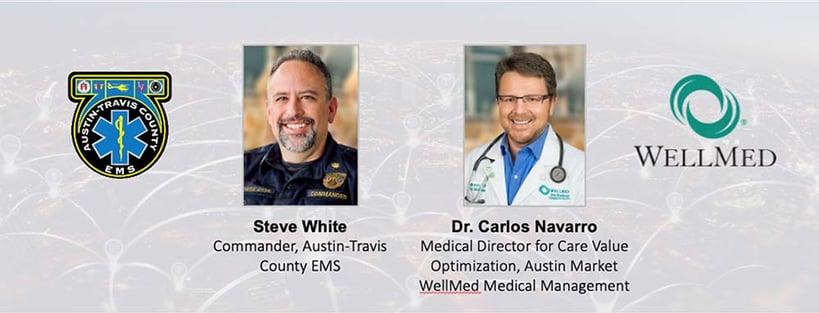
Steve White:
Thank you very much. I want to say thank you to JEMS and to Pulsara for giving us this opportunity to talk about some of the awesome things that are happening right now in our industry and being able to present our story to you. I get pretty excited about these things. So if I get a little animated, forgive me.
Basically, I want to set kind of the stage for this webinar today. So many times we come to trainings and we're talking about our high acuity patients: we're talking about our STEMIs, strokes, and severe traumas. Today, we want to flip it on its head a little bit and really focus on our low acuity calls. The roles of EMS are changing constantly. And as we accept our role in this modern health care system, we're going to have to switch our focus from those high acuity calls to our more frequent and higher percentage of our call volume, which are these low acuity calls.
So as we start this conversation, as we go through this presentation, the mindset that I want you to have is that we are not talking about really sick patients. We are talking about the lowest of the low acuity. And honestly, I think if you went to any paramedic and you put him or her in a situation where there was a STEMI or a stroke—something that actually involved life or death—they would be pretty comfortable with that. But if you give them something that maybe is a low acuity call with a complicated factor, such as a social work aspect, that's when a paramedic really becomes uncomfortable, and their most comfortable response is to just take that person to the hospital, which kind of punts it onto our health care system.
So what we want to talk about today is, how do you turn your employees in your department into force multipliers? You're always going to be asked to do more with less; that's never going away. And we really encountered that when COVID hit March of 2020. That first COVID surge was a wake-up call. And we identified that we needed an extra layer of triage in the process, beyond our triage system and our 911 call center. And we needed to be able to stratify those calls as they came in, because we needed to be able to at least give a recommendation of PPE to our providers when they arrived on-scene. But what we found is through that triage and that stratification, we can actually provide services while still having reduced EMS contacts and a reduced number of transports.
And for the first time in our industry and in my department, we found ourselves where you had to be sick enough to go to the hospital. You had to meet certain criteria because our healthcare system was overloaded. And so this started a process that we call PINTs, which stands for Paramedic Initiated Non-Transports. But it really set us up for being able to start mitigating calls with maybe something other than an emergency room or other than an ambulance.
And then right after COVID, we had two hurricanes and we had the ICE-pocalypse. Here in Texas, we're not really used to cold weather. We had a week of freezing temperatures with no electricity. And we keep finding ourselves in the same situation over and over again with all these crises. We have a higher call volume, we're in a staffing crisis, and we have an overloaded hospital system. So we had to come up with new and inventive ways to deal with these three big problems.
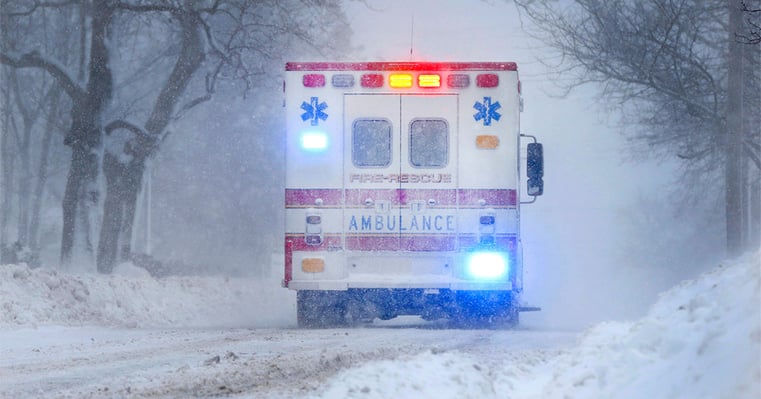
What we identified while going through that stratification process during COVID, is that we have more options than we thought. As these crises develop, what we find is that more people are using 911 as the entry point into healthcare.
The traditional role of EMS only dealing with life-threatening emergencies has evolved. Now, we are part of the healthcare industry and part of that whole health care system from start to finish. We really have to start focusing more on these low acuity patients and how can we help them the best.
And so we've kind of come up with this motto: the right resource at the right time, for the first time. We started a team called the C4, which stands for the Collaborative Care Communication Center. It's a team that ranges according to whatever problem we're trying to solve. During a high crisis moment like a surge in COVID, it could be up to 12 people, or now as we're coming out of COVID, it can be as small as six. But basically, this is a team of problem solvers. They are very experienced and have usually been with our department anywhere between 10 and 20 years. They have a lot of clinical experience and they are chosen based on their ability of good decision making.
What we've done is we've empowered them with as many tools as we possibly can to deal with low acuity patients. What they have done—and it's been a very team-driven project—is that they have developed pathways for patients. We have pathways for low acuity patients that range anywhere from alternative transport to treat-in-place, to telehealth, to long-term care, post-acute management, durable goods, home health, or hospice. All of these are pathways that they are able to use to get patients the treatment and the care they need right then, even though it may not be an emergency room.
Now, this team has kind of been injected with a really good idea that's come out of CMS and Medicare, which is the ET3 model. If you're not familiar with the ET3 model, it stands for Emergency Triage, Treatment, and Transport. It's an initiative that Medicare started to try to decrease the number of unnecessary hospital transports. ET3 has given EMS an advantage, especially in my community where we really focus on equity—if I have to offer it for someone of Medicare age, I'm going to offer it across the board to the entire community. Those principles that CMS has come up with have really guided us in implementing these new ideas and these new pathways to treat people outside of the emergency room and trying to get them the best care the first time. So the role of the C4 when it comes to dealing with these low acuity patients is as the clearing center, the clearinghouse. They manage all of the communication between the different entities. We set up these partnership agreements; some of them are through ET3, and some of them are not.
But in these partner agencies, we're able to refer patients and get them the care and services that otherwise they wouldn't normally have. And we're able to do that outside of the emergency room. That really frees up the healthcare system to deal with patients that really need it.
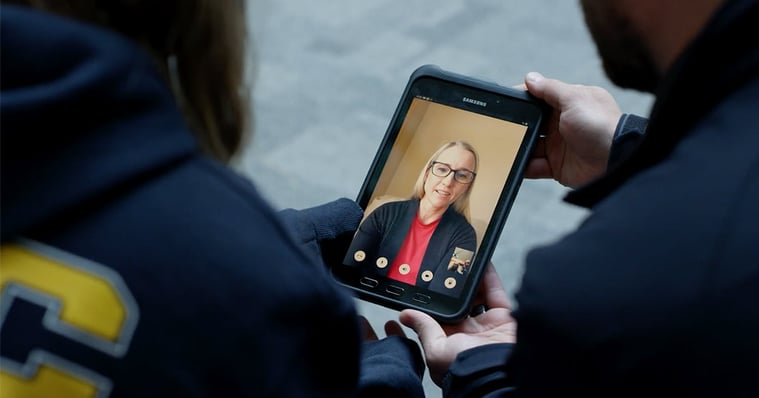
This idea really works, and it works really well. If this is the first time that you're hearing about an idea like this and you're an EMS administrator, I want to give you a perspective on how this affects patients, the department, the primary care physician, and the hospital.
So, I invited a colleague from one of our partner agencies. Dr. Carlos Navarro is the Medical Director for Care Value Optimization. Basically, Dr. Navarro is the innovator for his clinic. He's been working with the C4 for over a year now. We meet about every other week and we discuss new ideas and review patients that we've interacted with. Together, we're going to present a case study where we look at a patient in this program from as many different angles as we can—both the EMS perspective and the primary care perspective as well. We heavily leverage our technology in making this happen. And so he can also speak to interacting with that technology and how it works. With that, please welcome Dr. Carlos Navarro.
Carlos Navarro:
Thank you so much, Steve, for the kind introduction. It is a pleasure to be here. Like yourself, I can talk about this all day. I get excited about all these new initiatives that we're working on.
First, a little bit about myself, I'm a family physician by training. In addition to seeing my patients, I have the privilege of working with a team that focuses on enhancing the patient's experience of health care, improving population health, and reducing low-value care, which fits right in with what we're talking about today. And like you said, when I was preparing for this today—it's been a journey, right? We're live now, and we're seeing cases, but we've been working on this in collaboration with Austin-Travis County EMS for a while now, and it's good to see it finally moving and progressing. And now we're talking about, okay, what's next? What else can we do with this?
Let's go ahead and look at that case that we picked to show today. It's a very basic case, but it showcases the importance of the program. So this first patient that we're going to present is a 65-year-old female patient of one of our clinics here in Austin who has COPD, Cerebral Palsy, Peripheral Vascular disease, and major depression. She was alone at home and called EMS around 9:00 a.m. on a weekday. Her complaint was that she had dropped a jar on her leg three days prior, and her leg was hurting. It looked swollen and had an open wound, and she didn't know what to do.
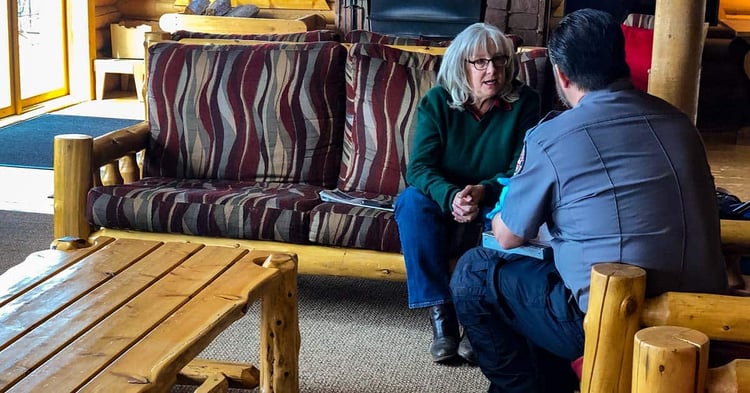
That's pretty common, right? But like Steve mentioned, most of the cases that we've handled are very basic things that we should be able to handle in the outpatient clinical setting, and really should not be going to the emergency room. So let's stop there and see how we would have handled that before we started with the program. Steve, walk us through this.
Steve White:
Yeah, I want to compare and contrast how we used to handle a patient like this, and how we do so now. This would be one of those situations where a paramedic might not be as comfortable because they are most comfortable in high acuity situations.
Two years ago, the only option would be to pick up that patient in the ambulance and take them to the emergency room, when that's maybe not the best course of action. The patient is going to be placed on the stretcher, they're going to be taken to the hospital, they're going to be seen by a doctor, and maybe have some X-rays. And then at that point, the doctors may prescribe an antibiotic if it's infected and might prescribe some pain medicine if it hurts. And then they're going to be given the discharge instructions to follow up with their primary care physician.
From an EMS standpoint, that call is going to take an ambulance about an hour and a half when you consider the response time, the scene time, transport time, and turnaround time. That patient's going to get a bill for the ambulance, they are going to get a bill for the hospital, and they're going to get a bill for the doctor seeing them. And when they come out of the emergency room, they are really not going to be that much better off than when they went in. They still have to have follow-up care; they still have to see their primary care physician. And now, they're out of pocket a substantial amount of money. I was going to bring in some figures to kind of represent that, but the more I looked into it, every city is different, every hospital is different, and every part of the country is different in how much they charge you just for walking in the door.
In this particular case, there would have been a burden on that healthcare system that maybe two years ago could have been easily handled, but not so much today. I wanted to ask Dr. Navarro: two years ago, if you had a patient that was coming out of the emergency room with follow-up instructions to meet with their primary care physician, what kind of challenge did that present to you?
Carlos Navarro:
Yeah, this is very critical. As you mentioned, this patient would go into the emergency room. And most of our patients and our clinics are seniors or have Medicare or Medicaid, or are disabled. They have a high level of medical complexity and often a lot of chronic illnesses. So if I put myself in the shoes of that emergency room provider, they don't know that patient, they don't have all the medical information, all the clinical data, the chart information from the clinic. And they don't have a solid way of discharging that patient home safely. Maybe not in this case, right? But in other cases, they may be kind of on the fence about, do I put this patient in the hospital for observation, or do I send them home? The hands of the emergency room physician are kind of tied there. So that's what we were facing, right? It's limited information combined with the complexity of patients, and it's clogging up the system.
Steve White:
Do you ever run into situations like in this instance, where it's a very low acuity call and they're calling 911 because that's pretty much their only option? Looking at this case, the crew actually documented in the narrative that she tried to call an Uber. But Uber said that they wouldn't take her if she wanted to go to the hospital as a patient. So now the patient is discharged home, they're supposed to do follow-up care, but how are they going to get to their follow-up care? At some point, it may be that they call 911 back because that is their only point of contact with healthcare.
Carlos Navarro:
Very true. And another related scenario is that sometimes, even when everything works correctly and they get a prescription, they may not have a way to get to the pharmacy to fill that prescription. Or, the antibiotic that was prescribed is not on their formulary, so they don't fill the antibiotic, they wait another four days, and then it's another call to EMS and back to the emergency room, right? So you can see how the waste in medical care carries on. On top of that, there was no contact with the office of the primary care physician, so they don't even know that the patient went to the emergency room. It's up to the patient to call in to schedule that follow-up appointment. It's very uncoordinated care.
Steve White:
Do you have access to their records from the emergency room as their primary care physician?
Carlos Navarro:
In our care model, WellMed, that's the hallmark of what we do, is to coordinate the care. We do have a team that looks for a census of the emergency room and the hospital, and they try to get those records and notify the primary care provider that one of our patients has been in the emergency room. So we proactively reach out to the patient as soon as we know that they're in a facility of any kind. It's something pretty unique to WellMed, and in previous positions I have held in the private fee-for-service world, where a lot of my colleagues practice, that's not the case. You just don't know when a patient went to the emergency room unless they call the clinic and ask for an appointment.
Steve White:
All right, let's take a look at the new way we do things. We're going to kind of break this down in small steps. We have the exact same patient, in the exact same scenario. Except this time, when the ambulance crew gets on-scene and they identify that this is a low acuity patient, they also identify that this is a WellMed patient, so they have options. The operational scope of this is that the crew would call the Collaborative Care Communication Center—the C4—and give them this information. And then we would use a piece of our technology, Pulsara, to notify Dr. Navarro that we have one of his patients. We can do that through Pulsara so he doesn't have to rely on a phone call, text message, or email; it's an instant notification that goes out to not only Dr. Navarro, but—Dr. Navarro, how many people will that notification go out to in your organization?
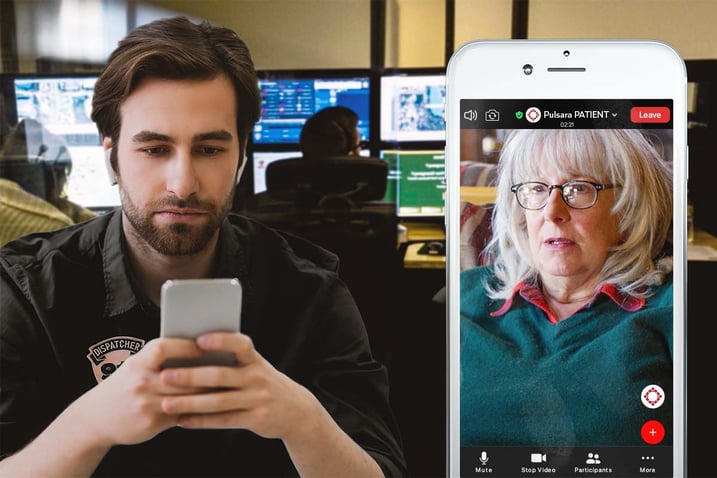
Carlos Navarro:
This was a critical piece when we were starting to discuss the project: how do we communicate with the primary care provider and our nurses or clinic supervisors that there's potentially a patient coming in? So we [used Pulsara to solve that challenge]. You can add people as you see fit. We have all of our primary care providers listed on the app, so the appropriate people will get the alert. And so with one activation, you can notify all of our teams in all the clinics, and it's instantaneous. They can see the patient's name, date of birth, a little bit of clinical information, vital signs, and they can quickly look in their electronic health record and see, okay, that's my patient. They can then jump in on the call and say, "Okay, how can I help? What can I do, this is one of our patients."
Steve White:
So once that ambulance crew activates this process, the Collaborative Care Communication Center starts the Pulsara app. At that point, you can have video conferencing between all parties. We've been doing this for a little while, and as of now we've done over 300 telehealth consults. I cannot stress enough the importance of being able to have that visual connection—with the doctor, the crew on-scene, and the patient. And when you get all three people on a video conference call together, it brings up a very interesting point: this is a completely new idea that most people are not going to be comfortable with. As such, it's important to get the patient's agreement that doing something different will work for them.
The video aspect of that is a huge, huge deal. We've done it over the phone and we've done it using Pulsara, but just audio calls. But really it's the video that makes the huge difference. It's the video that makes people feel more comfortable. So the C4 got everyone together, activated Pulsara, and on this specific patient, Dr. Navarro picked up. Dr. Navarro, what's your perception of the interaction with the patient in this situation?
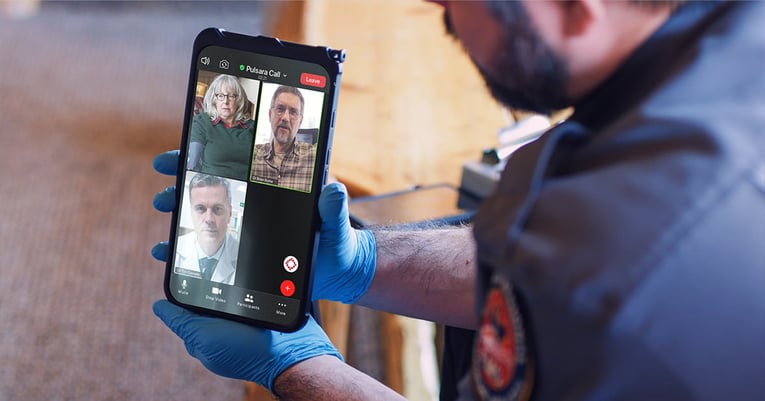
Carlos Navarro:
Yeah, so in this case it was great. They were able to say, "Hey, we can send you a picture of the wound right now." I was able to assess it and corroborate that yes, this is something we should definitely take care of in the clinic. At the same time, I was communicating with the primary care provider for that particular patient and updated him on, "Hey, one of your patients has a wound, this is what's going on." He said, "Sure, I'm ready to see her, I'm happy to work her into the schedule this morning." And within minutes, the clinic administrator and the staff from the clinic were ready. That's another thing that was important to us: not disrupting the flow of the clinic. Notifying them in advance that there's a patient coming gives them time to get the staff ready. And then there are no surprises, like— "Oh, my gosh, what's an ambulance doing here?"
Normally the process is the other way around: we call from the clinics to send the patient out, not accept the patient. So that was a culture change for us. In this case, it worked very well. They were ready for the patient to come in. It was seamless as the patient was seen, the wound was treated, and antibiotics were prescribed.
And another very important piece for a lot of our patients is transportation. This patient called EMS in the first place because she didn't have transportation. So how is she going to get back home? Well, we know that from the minute the call comes in that she's going to need transportation back. So we have what's called comfort care. We have a transportation system with drivers that can take our patients safely back home after they are discharged. They also get notified that there's a potential transport happening, because there's logistics behind that, too, right? We don't want patients to be stranded in the clinic for hours waiting for an Uber or a cab, or anything like that.
So the experience was really positive for the staff, for the primary care provider, and for the patient. It was a success story all around. She had a follow-up a couple of days after her visit via phone, and the wound was doing better. She's had no other visits to the emergency room since.
Steve White:
So let's go back to the point where you're having the conversation with the patient and the crew. What would happen if you didn't agree that this patient was appropriate for your clinic? Let's say you wanted to take X-rays, but maybe your X-ray machine was down. Or perhaps because you know of her past medical history because you have access to all of her records, what if you didn't agree that the clinic was the most appropriate thing? Can you walk us through what would then happen?
Carlos Navarro:
Yeah. And that brings up another great point, right? I think the beauty of this is just the opportunity to communicate and collaborate. We have EMS who are highly trained and highly skilled at what you guys do, which is triaging and ensuring that the right patient goes to the right place. We have the primary care providers in their clinic, we have the emergency room doctors in their setting, but we're not talking to each other. So this to me is the critical piece: having that on-the-spot collaboration. And kudos to you and your team. The interactions between myself and all the other providers that have used the app have been a very positive experience. Everybody is happy, upbeat, and excited to collaborate, which was one of the worries with the program, right? We weren't sure if there might be some pushback. So that part has worked beautifully.
And to answer your question, it has actually happened—not in this case, but we've had other cases where I participated and during the call, the vital signs changed, the clinical scenario changed, and then we said, "No, you know what, this is better if we don't take it to the clinic. Let's change course and go to the emergency room." It gives us an opportunity to improve the outcome of that case, even though we're not going to see them in the clinic, because I can request of your crew to please take this patient to this facility because I can contact our teams over there. We have our own hospitalist team. And we can notify them ahead of time that, "Hey, a patient is coming over to the facility. Don't go to the other facility, wait for them to arrive." And they can go and meet them in the emergency room and expedite their evaluation.
We have a lot of data on our side that shows that if our team is involved—our case manager, our nurses, our hospitalists—the coordination of care is a lot better. The average length of stay in the hospital is shorter, and the rates of readmission are lower, because they know how our system works. They communicate with the PCP at the time of discharge, ensure they have all their prescriptions, and make appointments for follow-up. So that's the beauty of this is—even if they do go to the emergency room, just having them go to the facility where there's a team waiting for that patient makes a huge difference.
In Part 2, Commander White and Dr. Navarro discuss the changes in their respective organizations since implementing the C4, and how they plan to make the program scalable. Check out the rest of the conversation here!
Pulsara is helping with COVID-19 management by helping mitigate patient surge, streamlining patient transfers, minimizing exposure, and more. Learn more about COVID-19 + Pulsara here.

December Recap After an incredibly busy events year with 102 conferences, trade shows, and sponsorships, December was on the slower side for us, with...

Editor's Note: In July 2025, EMS1 and Fitch & Associates released their annual EMS trend survey, What Paramedics Want, proudly sponsored by Pulsara....
![[PRESS RELEASE] Published Research Finds Up to 31% Faster STEMI Treatment Times in Rural Hospital Setting with Pulsara](https://www.pulsara.com/hubfs/_1_website-page-blog-assets/pulsara-hosp-teams-assign-cardio-stemi-rn-1200x701.jpg)
Published research shows how using Pulsara, alongside standardized field activation and a focus on stakeholder relationships, improves STEMI care and...